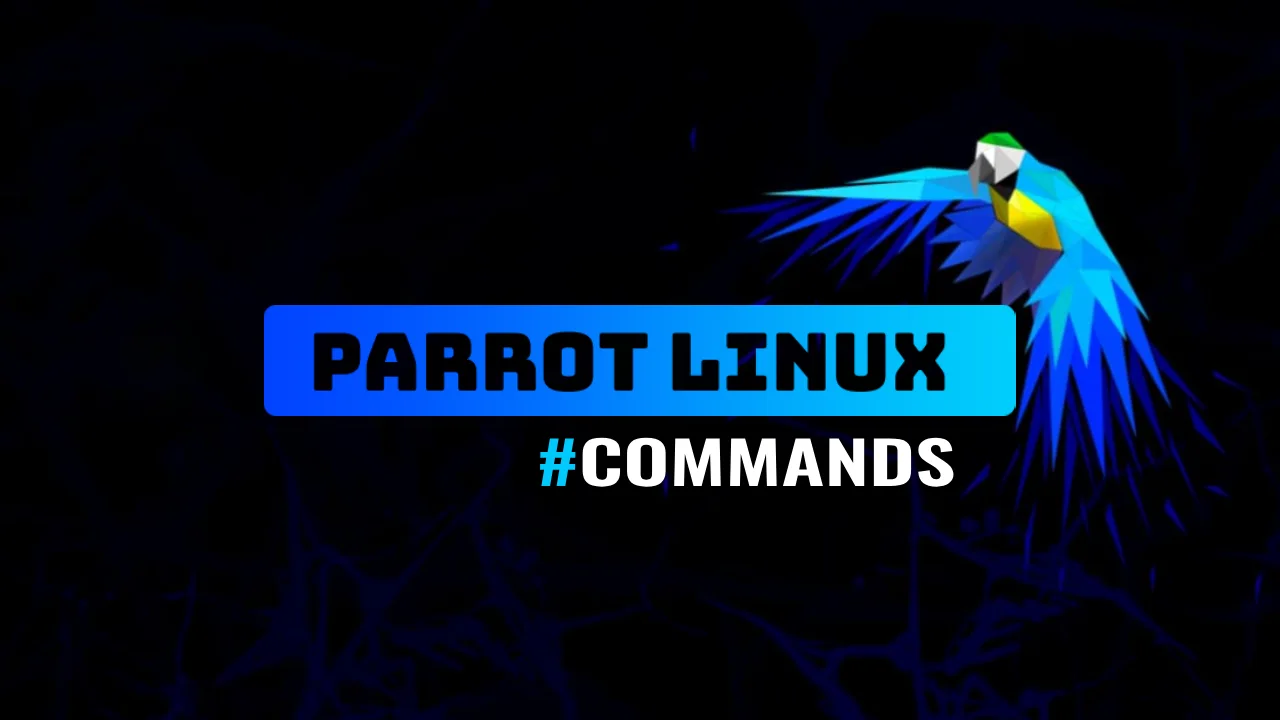Parrot Linux is a popular distribution of the Linux operating system that is specifically designed for security, privacy, and penetration testing. It provides a wide range of powerful tools and utilities for ethical hacking and digital forensics. In this article, we will explore an A to Z list of Parrot Linux commands, which will help you navigate and utilize the various features and functionalities of this powerful operating system.
Table of Contents
- Introduction to Parrot Linux
- Parrot Linux Commands
- 1. Essential Command-Line Basics
- 2. System Management Commands
- 3. Network Configuration and Monitoring
- 4. Information Gathering and Analysis
- 5. Vulnerability Assessment and Exploitation
- 6. Password Cracking and Brute Forcing
- 7. Forensics and Digital Investigation
- 8. File and Directory Management
- 9. Parrot Linux Commands for Package Management
- 10. System Maintenance and Updates
- 11. Security and Privacy Tools
- 12. Miscellaneous Parrot Linux Commands
- Tips and Tricks for Efficient Usage of Parrot Linux Commands
- Conclusion
- Frequently Asked Questions
Introduction to Parrot Linux
Parrot Linux is a security-oriented operating system based on Debian. It is designed to provide a secure environment for ethical hacking, penetration testing, and digital forensics. Parrot Linux comes with a vast array of pre-installed tools and utilities, making it a preferred choice for cybersecurity professionals and enthusiasts.
Parrot Linux Commands
1. Essential Command-Line Basics
Before diving into specific commands, it’s important to familiarize yourself with the basics of the command line interface in Parrot Linux. Here are some essential commands:
ls: List files and directoriescd: Change directorypwd: Print the current working directorymkdir: Create a new directoryrm: Remove files and directoriescp: Copy files and directoriesmv: Move or rename files and directoriescat: Display the contents of a filegrep: Search for a specific pattern in fileschmod: Change file permissionssudo: Execute a command with superuser privileges
2. System Management Commands
Parrot Linux provides various commands to manage the system. These commands allow you to control processes, monitor system resources, and configure system settings. Some important system management commands include:
ps: Display running processestop: Monitor system processes and resource usagedf: Show disk space usagedu: Estimate file and directory space usageshutdown: Shutdown or restart the systemreboot: Reboot the systemuseradd: Add a new useruserdel: Delete a userpasswd: Change user password
3. Network Configuration and Monitoring
Networking plays a vital role in cybersecurity, and Parrot Linux offers a comprehensive set of commands for network configuration and monitoring. These commands help you manage network interfaces, configure IP addresses, and troubleshoot network-related issues. Here are some key network commands:
ifconfig: Display or configure network interfacesping: Send ICMP echo requests to a network hostnetstat: Show network statisticsiwconfig: Configure wireless network interfacesroute: View or modify the IP routing tabletcpdump: Capture network trafficnmap: Network exploration and security auditing
4. Information Gathering and Analysis
In the field of cybersecurity, gathering information about target systems and analyzing it is crucial. Parrot Linux offers a range of tools and commands for information gathering and analysis. These commands assist in reconnaissance, vulnerability assessment, and system profiling. Some notable commands in this category include:
whois: Retrieve WHOIS information for a domaindig: DNS lookup utilitynslookup: Query DNS servers for informationtraceroute: Trace the route packets take to a network hostnbtscan: NetBIOS scannersslscan: SSL/TLS vulnerability scannernikto: Web server vulnerability scannerwireshark: Network protocol analyzer
5. Vulnerability Assessment and Exploitation
Ethical hackers and penetration testers often need tools and commands to assess the security vulnerabilities of target systems. Parrot Linux provides several powerful tools for vulnerability assessment and exploitation. These tools can be used to identify weaknesses and simulate attacks. Here are a few essential commands:
nmap: Port scanning and service detectionmetasploit: Exploitation frameworksqlmap: Automatic SQL injection and database takeover toolhydra: Password cracking tooljohn: John the Ripper password crackerarmitage: Graphical user interface for Metasploit
6. Password Cracking and Brute Forcing
Password cracking and brute-forcing techniques are commonly employed in security testing. Parrot Linux includes various tools and commands for these purposes. These tools can be used to test the strength of passwords and identify weak authentication mechanisms. Here are some notable commands:
hydra: Network login crackerjohn: Password cracker for various encryption formatshashcat: Advanced password recovery toolcewl: Custom wordlist generatorcrunch: Custom password list generatorpatator: Multi-purpose brute-forcing tool
7. Forensics and Digital Investigation
Digital forensics involves the collection, analysis, and preservation of digital evidence. Parrot Linux offers a range of tools and commands for forensic investigations. These tools help in data recovery, file analysis, and incident response. Some important commands include:
autopsy: Graphical interface for The Sleuth Kitforemost: Forensics application to recover files based on their headers, footers, and internal data structuresvolatility: Advanced memory forensics frameworkexiftool: Read, write, and edit metadata in filesscalpel: File carving and data recovery tool
8. File and Directory Management
Efficient file and directory management is essential in any operating system. Parrot Linux provides a set of commands to handle files and directories effectively. These commands allow you to create, delete, rename, and manipulate files and directories. Here are some commonly used commands:
ls: List files and directoriescd: Change directorypwd: Print the current working directorymkdir: Create a new directoryrm: Remove files and directoriescp: Copy files and directoriesmv: Move or rename files and directories
9. Parrot Linux Commands for Package Management
Parrot Linux is based on Debian, and it utilizes the APT package management system. This system simplifies the installation, update, and removal of software packages. Here are some essential package management commands:
apt-get: Command-line interface for managing packagesapt-cache: Query the APT package cacheaptitude: High-level interface for package management
10. System Maintenance and Updates
Regular system maintenance and updates are vital for optimal performance and security. Parrot Linux provides commands to keep the system up to date and ensure smooth operation. Some important commands for system
maintenance and updates include:
apt-get update: Update package listsapt-get upgrade: Upgrade installed packagesapt-get dist-upgrade: Upgrade the distributionapt-get autoremove: Remove unnecessary packagesapt-get clean: Remove downloaded package files
11. Security and Privacy Tools
Parrot Linux focuses on security and privacy, and it includes a variety of tools and commands to enhance these aspects. These tools aid in encryption, secure communication, and anonymity. Here are some notable security and privacy commands:
gpg: GNU Privacy Guard for encryption and signingtor: Anonymity onlineopenssl: Cryptographic toolkitssh: Secure shell for secure remote accessopenvpn: Virtual private network software
12. Miscellaneous Parrot Linux Commands
Parrot Linux offers several other useful commands that don’t fit into specific categories but are still important. These commands serve different purposes and can be beneficial in various scenarios. Here are a few miscellaneous commands:
screen: Terminal multiplexertmux: Terminal multiplexerwget: Command-line tool for downloading filescurl: Command-line tool for transferring datahtop: Interactive process viewerman: Manual pageshistory: Command history
Tips and Tricks for Efficient Usage of Parrot Linux Commands
To make the most out of Parrot Linux, here are some tips and tricks to enhance your efficiency:
- Utilize tab completion for commands and file paths.
- Take advantage of keyboard shortcuts to streamline your workflow.
- Customize your shell prompt for better visual feedback.
- Create aliases for frequently used commands.
- Explore the documentation and online resources to learn more about specific tools and commands.
Conclusion
Parrot Linux is a powerful operating system that provides a wide range of security-related tools and commands. In this article, we explored an A to Z list of Parrot Linux commands, covering various aspects of system management, networking, information gathering, vulnerability assessment, password cracking, forensics, file management, package management, system maintenance, security, and privacy. By mastering these commands, you can leverage the capabilities of Parrot Linux and enhance your skills in the field of cybersecurity.
Frequently Asked Questions
Q1: Can Parrot Linux be installed alongside other operating systems?
A: Yes, Parrot Linux can be installed as a dual-boot system alongside other operating systems like Windows or other Linux distributions.
Q2: Are all the tools and Parrot Linux command is legal to use?
A: Yes, all the tools and commands provided by Parrot Linux are legal to use for legitimate purposes such as security testing, ethical hacking, and digital forensics.
Q3: Can Parrot Linux Commands be used by beginners in cybersecurity?
A: While Parrot Linux is designed for security professionals, beginners can also start their journey with Parrot Linux due to its user-friendly interface and extensive documentation.
Q4: Is Parrot Linux suitable for everyday use as a primary operating system?
A: Parrot Linux is primarily focused on security and penetration testing, so it may not be ideal for everyday use as a primary operating system. However, it can be used as a live system or in a virtual environment for specific tasks.
Q5: How frequently is Parrot Linux updated with new tools and features?
A: Parrot Linux follows a rolling release model, which means it receives continuous updates with the latest tools, features, and security patches. Regular updates ensure that you have access to the most up-to-date tools and functionalities.
In conclusion, Parrot Linux is a comprehensive and powerful operating system that caters to the needs of cybersecurity professionals. With its extensive range of tools and commands, Parrot Linux empowers users to perform various security-related tasks efficiently and effectively. By mastering the A to Z list of Parrot Linux commands, you can unlock the full potential of this operating system and elevate your skills in the field of cybersecurity.



